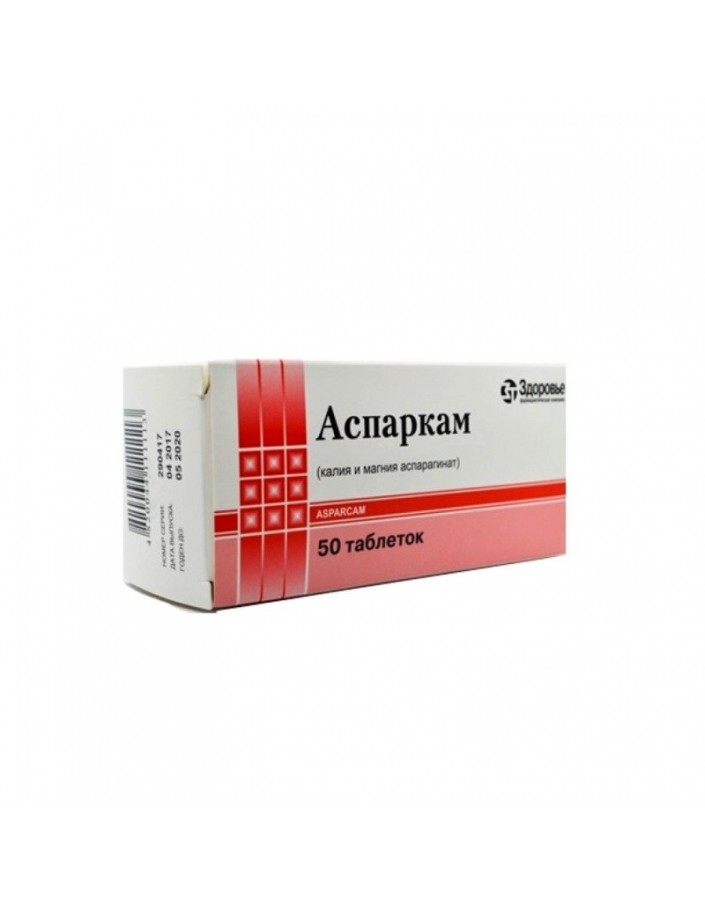




Security policy (edit with Customer reassurance module)

Delivery policy (edit with Customer reassurance module)

Return policy (edit with Customer reassurance module)
International non-proprietary name: potassium and Magnesium asparaginate.
Dosage Form: pills
Composition: 1 pill contains 0.175 g of potassium asparaginate and magnesium asparaginate and auxiliary substances: potato starch, polyvinylpyrrolidone, sugar, Calcium stearate; or pill mass “Asparkam” -0.495 g, calcium stearate to obtain a pill weighing 0.5 g.
Description: flat-colored pills of white color.
Pharmacological properties.
Pharmacotherapeutic group: potassium and magnesium drug
Pharmacodynamics.
Asparkam is a source of potassium and magnesium ions, regulates metabolic processes. The mechanism of action is presumably associated with the role of asparaginate as a carrier of magnesium and potassium ions in the intracellular space and the participation of asparaginate in metabolic processes. Thus, asparkam eliminates the imbalance of electrolytes, reduces the excitability and conductivity of the myocardium (moderate antiarrhythmic effect).
Pharmacokinetics.
It is easily absorbed when taken orally and relatively quickly excreted by the kidneys.
Indications for use.
Asparks are used in complex therapy for heart failure, coronary heart disease, hypokalemia, and cardiac rhythm disorders (including myocardial infarction, overdose of cardiac glycosides).
Contraindications.
Hypersensitivity to the drug, disorders of amino acid metabolism, arterial hypotension, acute and chronic renal failure, hyperkalemia, hypermagneemia, impaired atrioventricular conduction (AV block I-III), severe myasthenia, acute metabolic acidosis, dehydration (exicosis), hemolysis, Addison disease.
Be wary prescribed during pregnancy (especially the I term) and during lactation.
Dosage and administration.
Asparkam prescribed inside after eating.
Assign usually adults 1-2 pills 3 times a day. The course of treatment is 3-4 weeks. If necessary, repeat the course.
Side effect.
Nausea, vomiting, diarrhea, discomfort or burning in the epigastric region (in patients with anacid gastritis or cholecystitis), atrioventricular block, paradoxical reaction (increase in the number of extrasystoles), hyperkalemia (nausea, vomiting, diarrhea, parasthesia), hypermagnemia (reddening of the face, feeling of thirst, lowering of arterial pressure, hyporeflexia, respiratory depression, convulsions).
Overdose.
Symptoms: conduction disorders (especially in previous pathology of the cardiac conduction system).
Interaction with other drugs.
Pharmacodynamic: combined use with potassium-saving diuretics (triam-teren, spironolactone), beta-andrenoblokatorami, cyclosporine, Heparin, ACE inhibitors, nonsteroidal anti-inflammatory drugs increases the risk of hyperkalemia, up to the development of arrhythmia and asystole.
The use of potassium drugs in conjunction with glucocorticosteroids eliminates the last hypotension caused by the latter. Under the influence of K +, the undesirable effects of cardiac glycosides are reduced.
Mg2 + reduces the effect of neomycin, polymyxin B, Tetracycline and streptomycin.
Anesthetics increase the inhibitory effect of magnesium preparations on the central nervous system; with simultaneous use with atracuronium, decametonium, succinyl chloride and suxametonium, neuromuscular blockade may be increased; calcitrol increases the magnesium content in the blood plasma; Calcium preparations reduce the effect of magnesium preparations.
Pharmacokinetic: astringents and coating agents reduce the absorption of the drug in the gastrointestinal tract.
Storage conditions.
List B. In a dry place at a temperature of 18 ± 2 ºС. Keep out of reach of children.